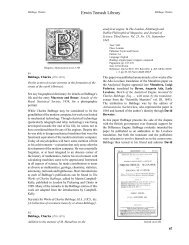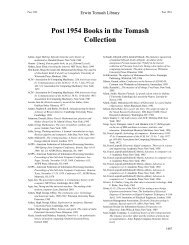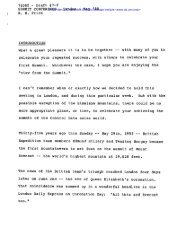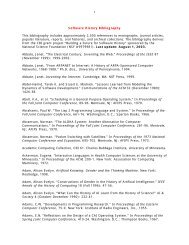M chapter.indd - Charles Babbage Institute
M chapter.indd - Charles Babbage Institute
M chapter.indd - Charles Babbage Institute
Create successful ePaper yourself
Turn your PDF publications into a flip-book with our unique Google optimized e-Paper software.
834<br />
Erwin Tomash Library<br />
Mallock, R. R. M. Mallock, R. R. M.<br />
M 24<br />
Mallock, R. R. M.<br />
An electrical calculating machine. In Proceedings of<br />
the Royal Society of London Series A, Vol. CXL, No.<br />
A841, May 3, 1933.<br />
Year: 1933<br />
Place: London<br />
Publisher: Royal Society of London<br />
Edition: 1st<br />
Language: English<br />
Binding: modern buckram boards<br />
Pagination: pp. 457–483<br />
Size: 244x160 mm<br />
Mallock was a demonstrator at the Cambridge University<br />
Engineering Laboratories.<br />
M 23 Frontispiece illustrating plane table, M 23<br />
The Mallock machine was designed in 1931 to solve<br />
linear simultaneous equations. It used a series of<br />
interconnected transformers to represent the unknowns;<br />
coils on the transformers represented coefficients, with<br />
the number of turns being adjusted to indicate the value.<br />
Each set of equations was set up as a closed circuit, and<br />
an alternating current was applied. When the system<br />
reached equilibrium, the solutions to the equations were<br />
read from meters attached to the machine. The actual<br />
machine was constructed, under Mallock’s supervision,<br />
at the Cambridge Scientific Instrument Company in<br />
1933. The company had intended to market additional<br />
copies of the machine but never did so because the device<br />
proved unable to deal with ill-conditioned equations.<br />
Illustrations available:<br />
Sample solution<br />
Wiring for a problem on the Mallock machine, M 24







